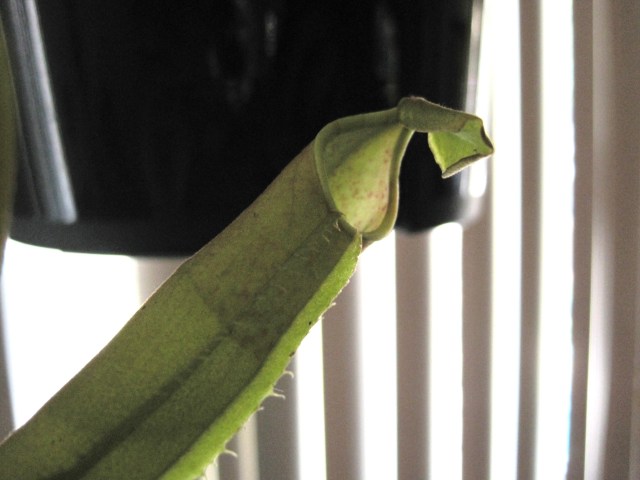Question
 wilting nepenthes lid
wilting nepenthes lid
Hi my name is Matt and I am having a little trouble with my nepenthes plant. I have had this n sanguinea orange plant for about a month now and I bought it with one medium sized pitcher.
But, I have noticed in the past couple of days the " lid " on the top of the pitcher is starting to curl on itself and when I touched it it was really soft and almost wilted.
I have been fertilizing this plant with some grow more orchid fertilizer by pouring it in the plants soil. But, I have also poured some fertilizer inside the pitcher to help it grow better. Was I wrong to do this ?
I am growing this plant near a window without a terrarium. I included a picture of this pitcher to help you.
thanks for your help
AnswerHi Matt,
Pitchers on Nepenthes are actually part of the leaf. Just like a leaf on any plant, they eventually die as new ones are produced. On a pitcher the lid will be the first part to start wilting when the pitcher is on it's way out. The lid will slowly wilt, followed by the upper part of the pitcher. The lower part will often remain for several more weeks. We have a super scientific method for determining when to cut it off; when we can't stand to look at them anymore, we cut them off.:) The leaf will remain green for about another month or so.
Reasons that pitchers die vary from age, to low light levels (the most common reason), short days in winter, too much fertilizer (they don't need bugs if they are getting lots of plant food) or being too cold or too hot. Being moved around too much, what I call the "Move it here, Move it there," syndrome, will cause non-pitchering also, or make a plant drop some. In general Nepenthes like things nice and boring; consistent temperature, watering, bright light, one spot. Here's a podcast we did awhile ago that might be helpful: http://www.youtube.com/watch?v=Zrd356J2d0g&feature=plcp&context=C3c7bdeeUDOEgsTo
I wanted to address the fertilizer also. If your plant is just getting natural light, limit your fertilizing to once a month until after the Spring Equinox, then increase to once every two weeks. Mix up no more than 1/4 teaspoon per gallon of water. The Gro-More mixes are good. During the winter when light levels are low, too much fertilizer will do more harm than good. Plants can't utilize the fertilizer in low light.
Good Growing!
Jeff Dallas
Sarracenia Northwest
http://www.cobraplant.com






